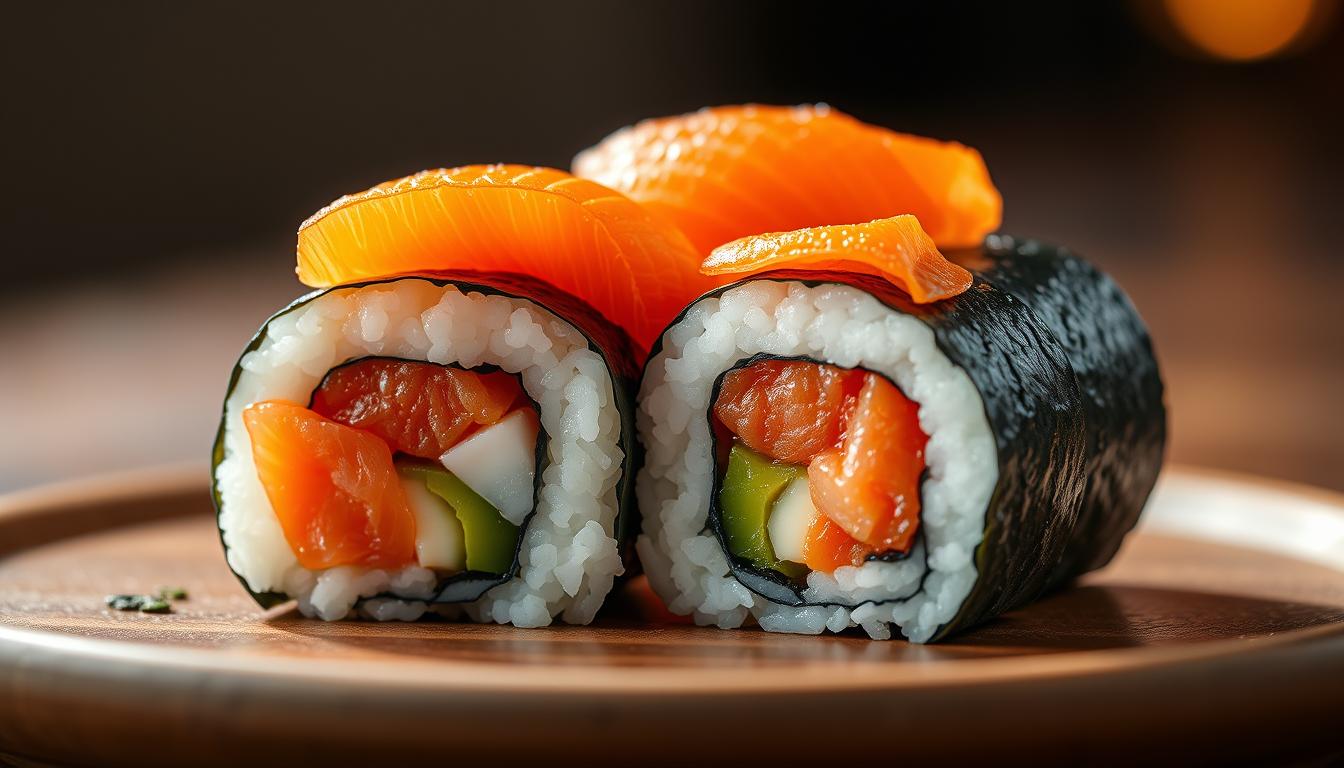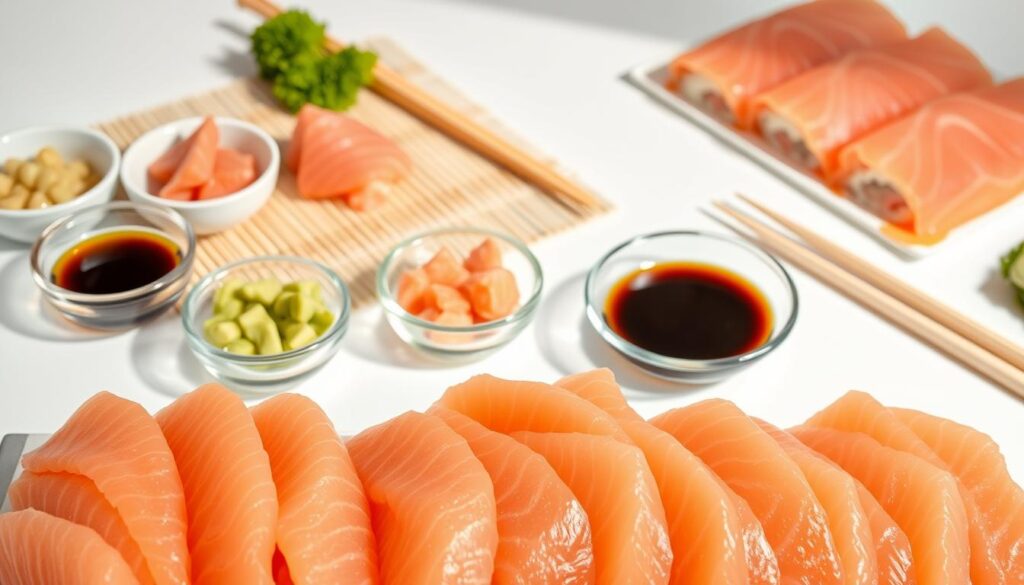Delicious Salmon Sushi Roll: A Flavorful Delight

The first time I tasted a salmon sushi roll, it was a game-changer. It opened my eyes to the world of Japanese cuisine. It turned a simple search for flavor into a deep love for making the perfect salmon sushi roll.
Back then, salmon wasn’t a big deal in Japanese sushi. But now, it’s a key player in modern sushi. Your adventure into salmon sushi rolls is a mix of old and new, blending tradition with innovation.
If you love sushi or just want to try something new, this guide is for you. You’ll learn how to make Salmon rolls that are as good as those in fancy restaurants. You’ll learn how to pick the best salmon and how to roll it like a pro. Soon, you’ll be making your own Japanese cuisine at home.
Table of Contents
Understanding Traditional Japanese Sushi Culture
Japanese cuisine is more than just cooking. It’s an art form that values raw fish, especially sashimi, deeply. For centuries, chefs have perfected techniques and added cultural meaning to it.
Salmon’s journey in Japanese food is interesting. At first, chefs were wary of using salmon in sushi. They worried about parasites and food safety.
The Evolution of Salmon in Japanese Cuisine
Traditionally, sushi focused on safe fish types. Salmon wasn’t one of them. Fishermen and chefs chose safer seafood instead.
- Early Japanese sushi used primarily local fish species
- Salmon was viewed with skepticism for raw consumption
- Strict food safety standards limited salmon’s use
Why Farmed Salmon Changed Sushi Making
Farmed salmon changed Japanese food. It made salmon safer for raw dishes like sashimi and sushi rolls.
Now, sushi chefs pick salmon carefully. They prefer wild-caught fish from trusted sources. This change has opened up new sushi ideas.
Modern Adaptations in Sushi Preparation
Today’s sushi chefs mix old ways with new ideas. They know how important proper fish handling and sourcing are. This mix creates a unique sushi experience.
- Rigorous fish selection processes
- Advanced freezing techniques
- Precise preparation methods
Learning about salmon’s journey in sushi makes you appreciate Japanese food more. It shows how something once avoided became a prized ingredient.
Essential Ingredients for the Perfect Salmon Sushi Roll
To make a perfect salmon sushi roll, you need top-notch ingredients. Each part plays a key role in making your dish stand out. Let’s explore what makes a great seafood roll.
Fresh, sushi-grade salmon is the base of your roll. It brings a rich taste and smooth texture. The right mix of ingredients will make your dish unforgettable.
- Sushi-grade salmon (primary protein)
- Nori seaweed sheets (for wrapping)
- Sushi rice (sticky, short-grain variety)
- Fresh cucumber (crisp vegetable component)
- Spicy mayo (signature sauce)
Nori seaweed is vital for your sushi. It keeps everything together and adds a unique ocean flavor. This flavor pairs well with the salmon.
| Ingredient | Purpose | Flavor Profile |
|---|---|---|
| Salmon | Primary protein | Rich, buttery |
| Nori Seaweed | Wrap and bind | Oceanic, mineral |
| Soy Sauce | Dipping/seasoning | Umami, salty |
Soy sauce is a must for finishing your roll. A little drizzle or dipping sauce can enhance the flavor. Try different brands to find your favorite.
Pro tip: Always choose the freshest ingredients for an authentic sushi experience.
Selecting High-Quality Sushi-Grade Salmon
Choosing the right salmon is key for tasty sushi at home. Raw fish needs careful picking for safety and flavor. Sashimi-grade salmon is the best quality for food lovers.
When looking for top salmon for sushi, consider a few important factors. These factors help find the best raw fish from regular seafood.
Different Types of Salmon for Sushi
Not all salmon is the same for sushi. Each type has its own taste and texture:
- King Salmon (Chinook): Rich, buttery texture
- Sockeye Salmon: Vibrant red color, lean meat
- Coho Salmon: Mild flavor, delicate texture
- Atlantic Salmon: Smooth, consistent quality
How to Check for Freshness
Finding fresh sashimi-grade salmon needs a close look. Look for these signs:
- Bright, translucent color
- Firm, elastic texture
- Clean, ocean-like smell
- No discoloration or browning
“The quality of your sushi begins with selecting the finest raw fish possible.” – Sushi Chef Recommendation
Storage and Handling Tips
| Storage Method | Temperature | Maximum Storage Time |
|---|---|---|
| Refrigeration | 32-38°F | 1-2 days |
| Freezing | 0°F or below | 3-4 months |
Buy sashimi-grade salmon from trusted fishmongers or seafood markets. Right handling stops bacteria growth and keeps quality high.
Pro tip: If unsure about salmon quality, ask your local fishmonger about the fish’s origin and processing method.
Mastering Sushi Rice Preparation
Preparing the perfect sushi rice is key to Japanese cuisine. It’s the base of your sushi roll, so making it right is crucial. Professional sushi chefs take great care and precision in preparing the rice.
To make great sushi rice, start with short-grain Japanese rice. It’s the right texture for sushi. Then, follow a special process to make it sticky and flavorful.
- Rinse rice thoroughly to remove excess starch
- Use the correct water-to-rice ratio (typically 1:1.1)
- Cook rice in a rice cooker or traditional pot
- Allow rice to rest after cooking
The seasoning mix is very important. You’ll need:
- Rice vinegar
- Sugar
- Salt
After cooking, mix the seasoning into the warm rice gently. Use a cutting motion to mix without mashing the rice. You want the rice to be glossy, slightly tangy, and stick together well.
Pro tip: Use a wooden or plastic bowl for mixing to prevent the rice from becoming too compact.
Temperature is key in making sushi rice. Cool the rice to room temperature before using it. This ensures the best texture and flavor for your sushi rolls.
Necessary Tools and Equipment for Making Salmon Sushi Roll
To make tasty maki rolls at home, you need the right tools. You don’t need a fancy kitchen to make delicious Salmon rolls.
Start your sushi-making journey with the basic equipment. It will help you make authentic maki rolls easily and accurately.
Essential Sushi-Making Tools
- Bamboo Mat (Makisu): The key to rolling maki rolls, making perfect shapes
- Sharp Chef’s Knife: Important for cutting fish and rolls cleanly
- Rice Cooker: Makes sure your sushi rice is always perfect
- Cutting Board: Use a wooden one for raw fish to avoid contamination
- Large Mixing Bowl: Needed for mixing and seasoning sushi rice
Optional Equipment for Enhanced Results
These tools are not necessary but can make your maki rolls even better:
- Rice Paddle: Helps mix sushi rice without it sticking together
- Digital Kitchen Scale: For accurate ingredient measurements
- Sushi Rolling Mat Cover: Keeps your mat clean and rice from sticking
- Professional Sushi Knife: Offers sharp cuts for advanced techniques
Good tools can make a big difference in your sushi-making at home. They help you create maki rolls that taste like they’re from a restaurant.
Step-by-Step Rolling Technique

Learning to make makizushi is all about precision and practice. It’s a skill that turns simple ingredients into a work of art. You’ll need a bamboo mat, nori sheets, sushi rice, and your favorite salmon fillings to make sushi like a pro at home.
First, get your workspace ready with everything you need. Place your bamboo mat out and make sure your hands are a bit damp. This helps the rice not stick to your hands.
- Put a sheet of nori on the bamboo mat, shiny side down
- Spread sushi rice evenly over the nori, leaving a small strip bare at the top
- Put salmon and other fillings horizontally across the rice
- Use the bamboo mat to lift and roll the nori tightly
- Apply gentle pressure to make a compact maki roll
Professional sushi chefs say to keep your rolls tight but not too tight. The secret is finding the right balance between structure and texture.
“Sushi is an art form that requires patience and precision” – Traditional Japanese Saying
When making maki rolls, you might face issues like uneven rice or rolls that are too loose. But don’t worry, with practice, you’ll get better and better.
| Rolling Technique | Difficulty Level | Tips |
|---|---|---|
| Basic Makizushi Roll | Beginner | Start with room temperature ingredients |
| Tight Salmon Roll | Intermediate | Use sharp knife for clean cuts |
| Complex Maki Variations | Advanced | Experiment with multiple fillings |
With regular practice, you’ll soon make beautiful salmon maki rolls that look like they’re from a top sushi restaurant.
Creating the Perfect Spicy Mayo Sauce
Spicy mayo is a key part of Japanese food that makes Salmon rolls taste amazing. It turns a simple sushi meal into a thrilling adventure for your taste buds.
The secret of spicy mayo is its mix of simple yet powerful ingredients. Japanese cooking is all about making complex flavors from just a few things.
Sauce Variations and Combinations
Making the best spicy mayo is all about finding the right mix. Here’s a basic recipe to start with:
- 1/2 cup Japanese mayonnaise
- 1-2 tablespoons sriracha sauce
- 1/2 teaspoon sesame oil
- Optional: pinch of garlic powder
“The key to great spicy mayo is finding your perfect heat-to-creaminess ratio.” – Sushi Chef Recommendation
Balancing Flavors and Heat Levels
When making spicy mayo for your salmon sushi, keep these tips in mind:
- Start with small amounts of sriracha
- Taste and gradually increase heat
- Use high-quality Japanese mayonnaise for authentic flavor
- Experiment with additional spices like wasabi or chili flakes
Your spicy mayo can change the game in Japanese food. It can turn a simple sushi roll into a memorable meal.
Popular Salmon Sushi Roll Variations
Exploring salmon sushi roll variations opens up a world of culinary creativity. Your sushi adventure can take many delicious turns. Unique combinations can transform the classic Salmon roll into an extraordinary dining experience.
Classic Salmon roll combinations offer something for every palate. Some of the most beloved varieties include:
- Salmon and avocado roll: A creamy, rich combination
- Spicy salmon roll: Featuring a kick of sriracha or spicy mayo
- Philadelphia roll: Incorporating cream cheese for a smooth texture
- Seattle roll: Combining salmon with cucumber for freshness
When preparing nigiri, chefs often experiment with different salmon preparations. The delicate art of nigiri allows for subtle flavor variations. These can elevate your sushi experience.
| Salmon Sushi Variation | Key Ingredients | Flavor Profile |
|---|---|---|
| California Salmon Roll | Salmon, crab, avocado | Creamy and mild |
| Spicy Salmon Roll | Salmon, spicy mayo, cucumber | Zesty and bold |
| Rainbow Salmon Roll | Salmon, assorted fish toppings | Complex and colorful |
Your Salmon roll journey can include pickled daikon and green onions for added texture and flavor. Pro tip: Experiment with different combinations to discover your perfect Salmon roll.
Complementary Ingredients and Toppings
Enjoying salmon sushi in Japanese cuisine is even better with the right sides. The perfect mix of toppings and sides makes your sushi roll taste amazing. It’s all about the flavors coming together.

Trying out different toppings lets you make your sushi roll special. Each topping adds something unique that goes well with the salmon. It’s a way to make your meal unforgettable.
Traditional Japanese Accompaniments
Classic sides for salmon sushi include:
- Wasabi: A spicy green paste that adds intense heat
- Pickled ginger (gari): Cleanses the palate between bites
- Soy sauce: Provides a salty, umami flavor
- Sesame seeds: Adds nutty crunch and visual appeal
Modern Fusion Elements
Today’s sushi chefs are trying new things. They add:
- Crispy tempura flakes
- Spicy mayo drizzle
- Truffle oil
- Citrus-infused ponzu sauce
- Microgreens and edible flowers
By trying these new ingredients, you can make your sushi experience unique. It’s a mix of old and new, Japanese and modern.
Plating and Presentation Tips
Mastering the art of plating is key in Japanese cuisine. The look of your salmon sushi roll matters as much as its taste. Professional chefs know that how you present a dish can turn it into a memorable experience.
Here are some tips for presenting your Salmon rolls:
- Use white ceramic plates for a striking contrast
- Arrange rolls in asymmetrical patterns
- Create negative space around the sushi
- Add colorful garnishes like shiso leaves or pickled ginger
Traditional Japanese cuisine values simplicity and elegance. Your plating should show this by keeping decorations simple yet meaningful. Use small ceramic dishes for soy sauce and wasabi, placing them thoughtfully around the main plate.
Color is important in Japanese sushi presentation. Choose colors that complement your salmon rolls. A sprinkle of black sesame seeds or a thin slice of green cucumber can add interest without overwhelming the dish.
“Beautiful food begins with thoughtful presentation” – Japanese Culinary Tradition
To add an authentic touch, learn traditional garnishing techniques. These small details can make your homemade meal feel like a restaurant-quality dish.
Health Benefits and Nutritional Value
Salmon sushi rolls are not just tasty. They are also full of nutrients. Enjoying raw fish in sushi gives your body many health benefits. Salmon is especially good for you, with a nutritional profile that boosts overall wellness.
Let’s look at the main nutritional benefits of salmon sushi:
- Omega-3 Fatty Acids: Salmon has heart-healthy omega-3s that help your brain and reduce inflammation
- High-Quality Protein: A single serving has a lot of protein for muscle health
- Essential Vitamins: It’s full of vitamin D, B12, and selenium
- Low-Calorie Option: It’s a healthy choice for those watching their weight
Raw fish in sushi has special nutritional benefits. Eating salmon raw keeps more of its nutrients. The seaweed and veggies add even more nutrition, making it a complete meal.
Salmon sushi isn’t just food—it’s a nutrient-dense experience that nourishes your body from the inside out.
For those watching their diet, salmon sushi is a good mix of proteins, healthy fats, and few carbs. Experts say eating seafood like salmon is key for staying healthy.
Conclusion
Making a tasty salmon sushi roll at home is easier than you think. Learning about Japanese cuisine and improving your rolling skills can turn your kitchen into a sushi bar. You’ll be able to make salmon sushi rolls just like in a restaurant.
Your cooking journey doesn’t stop here. Every salmon sushi roll you make is a chance to try new flavors and ingredients. Whether you’re new to cooking or have experience, this guide will help you get better at making sushi. Remember, making great sushi takes time, patience, and a love for Japanese food.
We encourage you to share your sushi-making stories, special recipes, and any challenges you face. Your journey with salmon sushi rolls is about more than just cooking. It’s about connecting with a deep culinary tradition. Enjoy the flavors, and keep exploring the world of homemade sushi.
